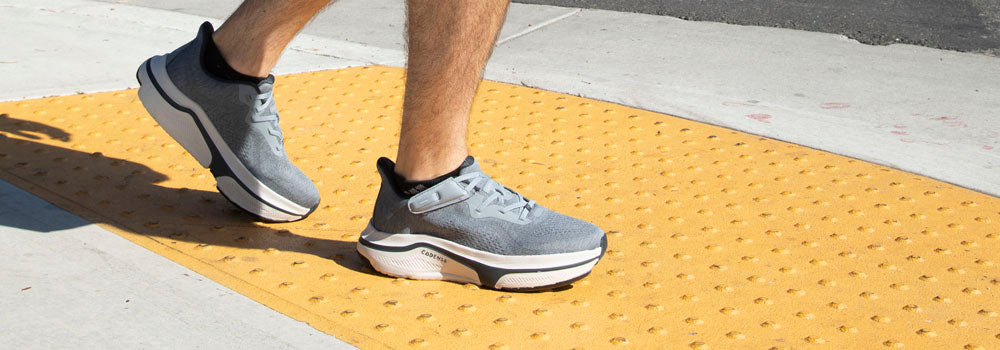Parkinson’s Foot Pain: Problems and Treatments
Feb 22, 2024
You likely know that Parkinson’s is a condition that creates challenges with movements such as walking. But Parkinson’s also can cause multiple types of pain. Some Parkinson’s pain may affect your feet directly. When that happens, it can add to your difficulties walking and decrease your quality of life.
This post will dive into Parkinson’s foot pain problems. We will discuss some common causes of Parkinson’s foot pain, along with what you can do to alleviate it. In addition, we will offer recommendations for how to improve the Parkinson’s walk through gait training exercises and appropriate footwear.
What Foot Problems are Associated with Parkinson’s Disease?
A number of different foot problems can be linked to Parkinson’s disease. In the sections below, we discuss how dystonia and swelling might affect you.
Dystonia
Sometimes when you have Parkinson’s, your toes might abruptly curl and hurt. This can also happen with your fingers, or even in the throat, neck and face.
The Parkinson’s Foundation explains that this is a type of muscle spasm called “dystonia.” The pain associated with it is “dystonic pain.” These unpleasant spasm will afflict around half of people with Parkinson’s at some point.
The foundation states that you are more likely to experience this symptom in the morning hours, or in response to triggering movements. But it can also strike at other times. Certain medications that are used to treat Parkinson’s may produce dystonic pain when levels fluctuate.
Swelling or Oedema
When you have Parkinson’s, the difficulties walking may cause you to adopt a sedentary lifestyle. If you do, a fluid buildup in your lower extremities called “oedema” can occur, producing swelling in your feet and ankles.
Sometimes, taking certain medications for PD might also lead to swelling in your lower body.

Generally speaking, the swelling in your lower legs and feet should not cause pain by itself, although it can cause an uncomfortable heavy sensation.
But if your shoes are too tight when your feet are swollen, they may pinch your feet in a painful manner.
Other Types of Pain in Parkinson’s Disease
While our focus is on swelling and dystonia in this post, we do briefly want to mention that there are other types of pain that can also affect you when you have Parkinson’s disease.
The Parkinson’s Foundation reports that many people with PD experience musculoskeletal pain, neuropathic pain, and (less commonly) central pain.
Sometimes, the neuropathic pain takes the form of peripheral neuropathy, a type of nerve pain that affects the hands and/or feet.
Who Helps Alleviate Parkinson’s Foot Pain?
While your primary doctor may be able to give you some help with treating Parkinson’s foot pain, you will need to consult with a specialist if your foot pain is especially problematic.
The type of medical specialist who focuses on foot care is known as a podiatrist, or sometimes as a chiropodist. A podiatrist or chiropodist has the advanced training and experience in foot problems to provide you with a deeper understanding of the issues you are experiencing and make personalized recommendations for how you can treat your foot pain.
What Types of Footwear are Useful for People with Parkinson’s?
Wearing healthy shoes is important for everyone. But when you have foot pain from PD, it becomes critical. The right shoes can help you to alleviate pain, get more exercise, and manage the gait-related challenges that come with Parkinson’s walk. In fact, finding comfortable, supportive footwear makes it easier and safer to do gait training exercises.

Our top recommendation for Parkinson’s footwear is Cadense Original Adaptive Shoes for men and women. What makes these shoes stand out is their patented variable friction technology.
This technology helps to mitigate a common issue that occurs with Parkinson’s gait, which is the tendency for the toes to drag along the ground.
If you are unable to lift and place your feet in a natural way due to Parkinson’s, the adaptive technology in Cadense shoes will help you to “glide” across obstacles, preventing tripping and falling.

In addition, Cadense shoes are lightweight, reducing fatigue as you walk. They have high quality tread, providing a firm grip on a variety of surfaces. They also offer comfortable cushioning and support along with a wide base that helps increase stability. Explore the Cadense collection of shoes for Parkinson’s disease.
Choosing the Right Size Footwear for Parkinson’s
As we discussed earlier in this post, swelling feet can be a symptom of Parkinson’s. If you experience foot swelling and your shoes are too tight, you may experience pain or circulatory problems.
At the same time, the swelling may not be present constantly. This can make it a challenge to find the right size of shoes when you have PD.
One option is to get shoes that have adjustable laces that you can loosen and tighten as needed to get the right fit based on the swelling you are experiencing.
Another option is to buy shoes in multiple sizes. Get a smaller pair for when you do not have swelling, and a half size or full size up for when you do experience swelling. You may need to try on shoes at different times to establish the right sizes for your individual needs. You can then switch shoes as needed for your symptoms.
FAQs
Here are answers to some frequently asked questions about Parkinson’s disease and foot health.
Is foot pain a symptom of Parkinson’s disease?
Yes, foot pain can be a symptom of Parkinson’s disease. In fact, more than one type of foot pain can be a symptom of PD, including neuropathic or dystonic foot pain. Swelling may also cause pain if your shoes are too tight. Central pain may sometimes affect the feet as well (in some patients, it can affect the whole body).
Can Parkinson’s cause neuropathy in feet?
Yes, Parkinson’s can lead to peripheral neuropathy in around 40% of patients. The linked study states that peripheral neuropathy not only causes pain, but also can make it harder to maintain a natural gait and keep your balance.
What are the symptoms of dystonia in the feet?
If you experience dystonia in your feet, here are some common signs and symptoms according to Johns Hopkins Medicine:
- Your toes may curl up in a painful and involuntary way.
- You might experience a cramp in your foot.
- There could be painful contractions in your foot.
- Your foot may drag as you try to walk.
- You no longer have full motor control over your foot.
If you experience dystonia in other parts of your body, you may have different symptoms. For example, in your face, it can lead to involuntary fast blinking.
Dystonia can be “focal,” where it only affects one part of your body (i.e. your foot). But there are other types of dystonia that can affect more than one body part and/or side of your body.
What triggers foot dystonia?
As discussed earlier in this post, certain movements may trigger the unpleasant sensation of foot dystonia. Medication fluctuations as well as the time of day can trigger it as well. It is more common to feel dystonic foot pain in the morning.

